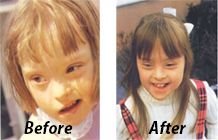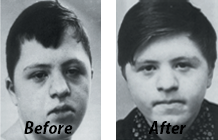Early intervention of Down syndrome infants and children with precursor stem cell therapy can make a difference in maximising their potential abilities for a better quality life. Regular screening for common medical problems, a conducive family environment and vocational training can improve the overall development of Down syndrome. Medical textbooks state that genetic and chromosomal disorders have no known treatment. Numerous Down syndrome children in Germany, Spain, Russia, USA etc. prior to 1957, had already been treated with precursor stem cell therapy before the age of 13. The results concluded that there is a statistically significant improvement in height, IQ, concentration, speech, motor skills and immune system. With each subsequent precursor stem cell therapy carried out at an early stage, the typical features of Down syndrome became less pronounced and the immunological deficiencies are corrected. Down syndrome is one of many conditions which have responded dramatically to precursor stem cell therapy.
Down Syndrome
TREATMENT
CASE STUDY
More than 5 thousands patients to date undergone treatment with success

Examples of before and after pictures of Down Syndrome patients with precursor stem cell therapy

The transformation from an uncontrolled mimic to a normal facial expression

From 1½ years old to 10 years old with controlled, clear facial expression, speaks fluently, reads books and writes accurately

9½ years old to 10½ years old with improvements
CAUSES AND SYMPTOMS
Down syndrome with the most frequent and best known chromosomal disorder Trisomy 21, is a condition caused by an error in cell division that results in chromosomal abnormalities. Such chromosomal disorder delays the development of a child. It affects about one in every 700 babies. The younger the fetus is, the higher the tendency for chromosomal abnormalities to occur in human. As a woman’s age increases, the risk of having a Down syndrome baby increases significantly. It involves abnormalities of physical and mental development as well as weakness of the immune system. Often Down syndrome is associated with some impairment of cognitive ability and physical growth as well as facial appearance. No one individual with Down syndrome will have all of the features mentioned. The most common features associated with Down syndrome include:
- Flat facial profile
- Small abnormally shaped ears
- Excessive ability to extend joints (hyperflexibility)
- White spots on iris (Brushfield spots)
- Upward slanting eyes
- Low set nose
- Short neck
- Dental anomalies
- Enlarged tongue
- Single deep crease on palm
- Malformed 5th finger
- Wide space between big and second toe
- Shorter than normal height

DIAGNOSIS
While Down syndrome is a chromosomal disorder, it is usually identified in a baby at birth through observation of the common physical characteristics. Once this suspicion is raised, the doctor will request a blood test called a chromosomal karyotype in order to verify the presence of the disorder. Physical development in a baby with Down syndrome occurs at a slower rate because of weak and floppy muscles. Speech is delayed. Lifespan is short but without congenital heart defects and serious immunological deficiencies. Patients normally can live up to 60 years. Down syndrome patients with mosaic form of Trisomy 21 can be fertile and have normal offsprings.
COGNITIVE DEVELOPMENT
Cognitive development as pertaining to perception, memory, judgement and reasoning in children with Down syndrome is quite variable. Ideally, the identification of the best methods of teaching each particular child begins soon after birth through early intervention programmes. Since children with Down syndrome have a wide range of abilities, success at school can vary greatly. The cognitive problems that are found among Down syndrome children can also be found among typical children. Therefore, parents can use general programmes that are offered through schools.
Language skills show a difference between understanding speech and expressing speech. Commonly, children with Down syndrome have a speech delay and require speech therapy to improve expressive language. Fine motor skills are also delayed and often lag behind gross motor skills and can interfere with cognitive development.
THERAPEUTIC PRINCIPLES
- Regulation of endocrine balance
- Elimination of increasing delay in brain development
- Correct immunological deficiencies
- Rehabilitation of all body systems (exercise, speech therapy, etc.)
THE FACTS ON DOWN SYNDROME
Never say that one has a Down syndrome child, or someone with Down’s or suffering from Down syndrome.
Down syndrome, the preferred term, Down’s syndrome or trisomy 21 is a condition. No one can suffer from it. It’s not a disease.
The right examples: “I have a child with Down syndrome.” or “Robert has Down syndrome.”
This is the thrust of the arguments in a two-part Bernama report in conjunction with World Down Syndrome Day on March 21.
Down syndrome, named after John Langdon Down, the British physician who described the syndrome in 1866, is the most common chromosomal abnormality caused by the presence of all or part of a third copy of chromosome 21.

